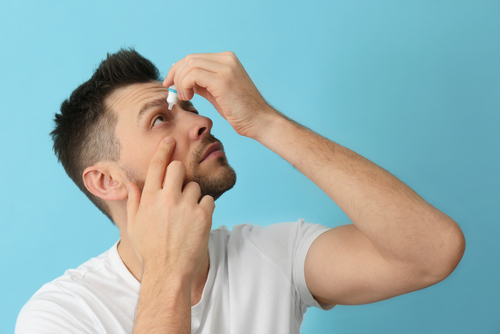10 Ways to Treat Your Dry Eyes

If you’ve got dry, itchy, red, irritated eyes, or if you wake up with crusty eyelids, you may have dry eye syndrome or blepharitis.
Keep reading to learn ten ways to treat dry eyes!
What Is Dry Eye?
Dry eye occurs when your eyes aren’t able to produce enough tears, or they cannot produce sufficient quality tears to keep your eyes moist and healthy. Tears aren’t all the same.
Like a recipe, good-quality tears require the right balance of ingredients. To effectively cleanse and protect, tears need enough oil to lubricate the eye’s surface.
How Lipids Protect Your Eyes
Meibomian glands at the end of the eyelids produce the oil that keeps your eyes moisturized. When you blink, pressure is put on these glands, and lipids are released.
Lipids prevent evaporation of the eye’s natural moisture. When the meibomian glands are blocked, they don’t produce enough lipids to protect the eye.
Eyelid Irritation and Blepharitis
One result of meibomian gland problems is eyelid irritation. If you’re noticing that the edge of your eyelids is red, flaky, crusted, or sticky, you may have a condition known as blepharitis.
Other causes of blepharitis include seborrheic dermatitis, which is the scalp and eyebrows dandruff. It can also be an allergic reaction to eye medications, contact lens solutions, eye makeup, or eyelash mites.
At-Home Dry Eye Treatments
If you’re noticing the early signs of dry eye, there are several doctor-recommended home remedies you can try to manage the symptoms.
1. Use Over-The-Counter Eyedrops and Artificial Tears
They’ll supplement your own tears, help keep your eye moist and ease discomfort. They’re an easy first step in combatting dry eye.
2. Drink Water Throughout The Day
Staying hydrated helps you and your eyes. It’s a whole-body benefit that costs nothing and is especially important during the hot summer months.
3. Think About Blinking
When you’re on a computer or mobile device, you blink less. Not blinking dries out your eyes.
Help your eyes out by taking frequent breaks away from your screen. If you can’t do that, pause to blink for a few seconds.
Make it part of your routine, like blinking twice each time you read to the end of a page.
4. Apply a Warm Compress
Heat and moisture from a washcloth soaked in water, wrung out, and placed over your eyes is a soothing solution. It can help release those essential lipids that keep your eye moist and prevent evaporation.
5. Cleanse Your Eyes
Following the warm compress, scrub your eyelids gently with a fresh washcloth or Q-tip. Wet either with warm water and a few drops of diluted baby shampoo.
Use a different cloth or Q-tip for each eye.
6. Increase The Humidity
Use a humidifier at work and in your bedroom.
7. Reduce Irritants
Avoid makeup, soaps, and medications around the eye.
Vermont Eye Laser treatments
Talk to your Vermont Eye Laser doctor about possible options when dry eye or blepharitis causes significant discomfort and impacts your everyday life.
8. Steroid Eyedrops
Prescription eye drops such as Restasis or Xiidra can address inflammation and improve dry eye symptoms.
9. Antibiotics
To reduce bacteria on the eyelids, your eye doctor may prescribe antibiotic eye drops, ointments, or oral medications such as Doxycycline.
11. Dry Eye Procedures
Further treatment may be necessary for more severe cases. Eye doctors perform treatments such as inserting punctal plugs or punctal cauterization, which can help improve tear quality and reduce discomfort and symptoms.
You can manage both dry eye and blepharitis in their early stages. Choose three at-home remedies, add them to your daily routine, and schedule regular eye exams at Vermont Eye Laser to stay on top of your eye health.
Do you want to learn more about dry eye treatment? Schedule an appointment at Vermont Eye and Laser in Burlington, VT, today!



